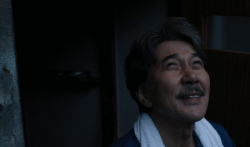Dionysus conjures the image of a smiling man with a flowing black beard, passing around grapes and dancing through the forest. As the Greek god of wine, festivities, and theater, you would think Dionysus didn’t have a bad bone in his body. Of course, if high school English taught us anything, it’s that all gods have a dark side. And for Dionysus that is the power to temporarily drive his women followers, the Bacchae, completely insane. With the wave of a hand or a kiss on the forehead, these Grecian women would lose all sense, tearing through the woods eating animals, shouting and dancing uncontrollably. The story of the Bacchic women is dark, terrifying, and little-known.
Carol Churchill’s A Mouthful of Birds resurrects the story of the Bacchae, combining gruesome mythological tales with our modern world. Director Brendan Quinn (COL ‘14) found that Churchill’s masterful writing and adept combination of psychology and Greek tragedy allows both him and audience members “to have their artistic imagination ignited in a way many people can respond to” and chose it for his senior thesis project.
Divided into several vignettes and moments of well-choreographed dance, Mouthful is often defined by the divides in its theatrical elements. The cast is split between the mythical, including Dionysus (Chris Coffrey , COL ‘16) and Semele (Norah Rosengarten, COL ‘14) and the modern, a group of Bacchae controlled by Dionysus. The mythological characters are constantly on stage, invisibly watching the modern characters struggle with their innermost demons, and, according to producer Sarah Konig (COL ’16), “manipulating the situation so things go their way.” Just as in Greek myth, Dionysus’s kiss on a character’s forehead causes a transformation, forcing the characters to fall into a craze and to become the Bacchic followers of myth.
Each act is dedicated to the problems of one particular member of the ensemble. Some are easy to relate to, while others are confusing and, at times, uncomfortable. Yvonne (Natalie Caceres, MSB ‘16) faces her alcoholism, an unfortunate and familiar issue. But when Lena (Maddie Kelley, COL’16) is depicted as openly fighting with her inner demon, screaming as she slowly spirals into insanity, the play becomes difficult to watch amidst her screams of pain and fear that drive her to murder. Other characters explore themes of gender identity, dark magic, and one character’s mental collapse when he falls madly in love with a pig.
What’s most interesting about Churchill’s work is her ability to question society’s conventions. Mouthful combines the stories of “people who feel the need to express themselves without conforming to norms,” Quinn says. “As a result they often experience a deep internal struggle, which the play makes completely visible.”
Although A Mouthful of Birds is serious in content, there are several moments of levity and beauty throughout the play. The dance scenes, in particular, are notable and not only do an excellent job of transitioning, but also gives the audience an emotional breather, while allowing the actors to “express themselves in ways words merely cannot describe” according to both Quinn and Konig.
What was Churchill’s intention in writing A Mouthful of Birds? Did she intend to illustrate how society has progressed as a whole? Was she saying that even today, we are prone to returning to our basic instincts? Are we not that different from the Bacchic women at all? Konig believes that Churchill “is bringing into question ‘what is normal.’ Most of these characters originally have extreme responses to daily life, but in the end, their responses all appear appropriate to their struggle.”
In A Mouthful of Birds, Churchill brilliantly exposes the human condition and its flaws by forcing us to suspend our disbelief. According to Churchill, even amid the growth of civilization, science, and technology, we are just as likely to return to our primal natures as before. One scene in particular, involving a fruit dance, epitomizes the inconsistency of the human mind: at one moment the ensemble is dancing harmoniously and laughing, and the next, as if by the wave of the hand or a kiss on the forehead, they are tearing one another apart.





